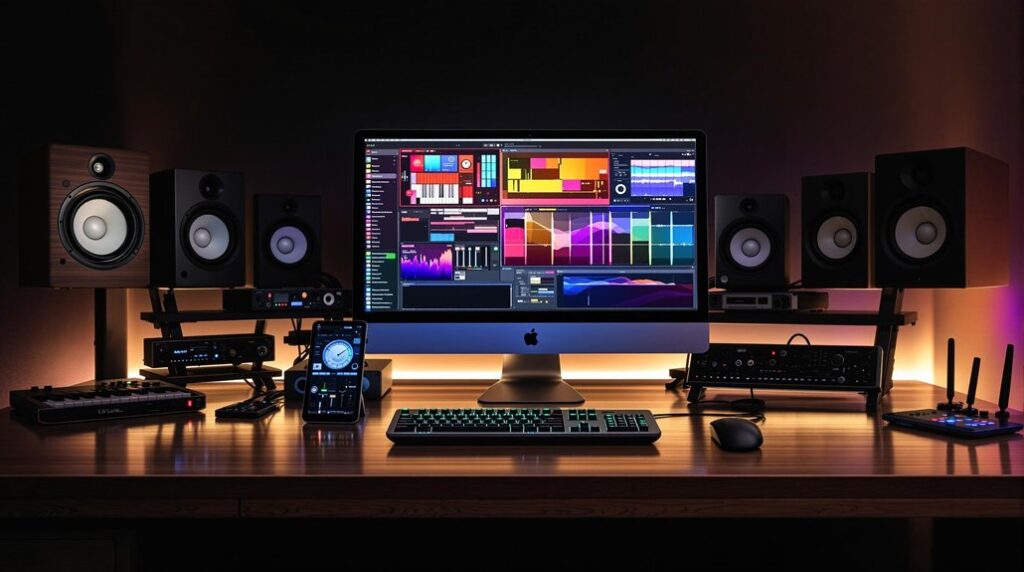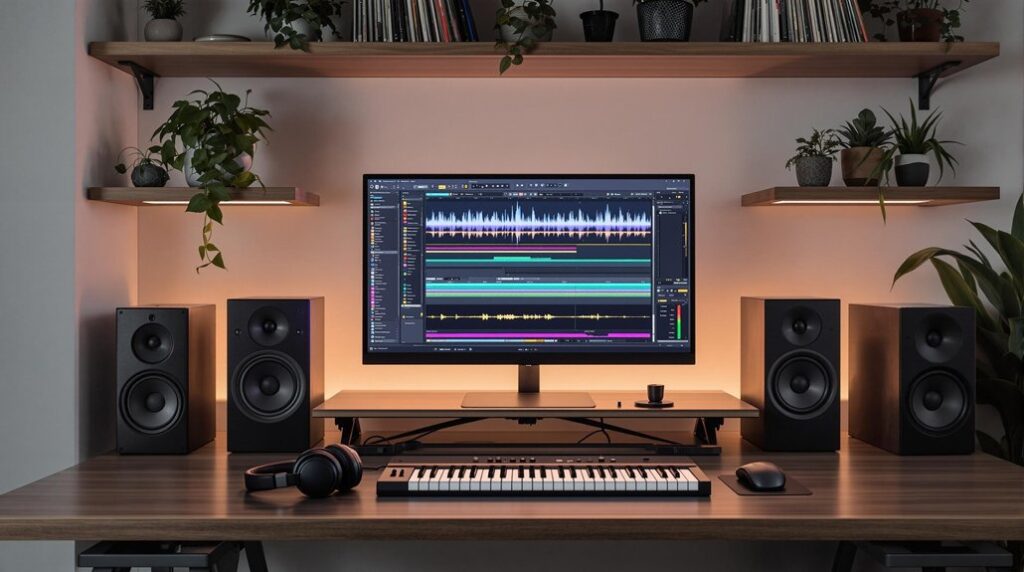To master the pumping effect using sidechain compression in Ableton, follow these three simple steps. First, select your target track, such as a synth or bass line, and insert a compressor plugin. Activate the sidechain input option and choose an audio source, typically a kick drum. Finally, adjust the threshold, ratio, attack, and release settings to achieve the desired volume ducking. Experiment with the attack for responsiveness and tweak the release time for a tighter or more natural sound. Continue exploring these parameters to reveal further creative possibilities in your music production.
Key Takeaways
- Select your target track, insert a compressor, and activate the sidechain input in the compressor settings.
- Choose a kick drum or other audio source as the sidechain trigger from the dropdown menu.
- Adjust the threshold, ratio, attack, and release settings to achieve the desired pumping effect.
- Experiment with attack and release times to control responsiveness and overall feel of the compression.
- Monitor gain reduction visually to avoid over-compression and maintain a balanced mix.
Understanding Sidechain Compression
Sidechain compression is a pivotal technique in audio production, particularly within the realm of electronic music. This dynamic processing method reduces the volume of one audio track when another track’s signal exceeds a predetermined threshold, producing a distinctive “pumping” effect.
In music production, this technique enhances clarity by allowing essential elements, such as the kick drum, to emerge prominently in the mix. To implement sidechain compression effectively, a compressor with sidechain capabilities is necessary, enabling users to designate the audio signal that triggers compression on the target track.
Key parameters, including threshold, ratio, attack, and release, must be finely tuned to achieve the desired intensity and smoothness. Additionally, sidechain compression can creatively enhance various elements, adding rhythmic interest and dynamic depth. This technique is especially vital for maintaining vocal clarity in dense mixes, ensuring that vocals are not overshadowed by other instruments.
Setting Up Sidechain in Ableton
How can one effectively set up sidechain compression in Ableton? Begin by selecting the track to be affected, such as a synth or bass line.
Follow these steps to implement the sidechain effect:
- Insert a compressor plugin onto the target track.
- Activate the sidechain input option within the compressor settings.
- Choose the audio source (commonly a kick drum) from the sidechain input dropdown.
- Adjust the compressor’s threshold, ratio, attack, and release settings to control the volume ducking.
Utilize visual feedback tools like meters and waveforms to monitor levels, ensuring that the sidechain compression enhances the mix while avoiding over-compression. Additionally, it’s important to experiment with different triggers to create unique sidechain results in your production.
This setup is essential for achieving that characteristic pumping effect in your music production.
Fine-Tuning the Pumping Effect
After establishing the basic sidechain setup, the next step involves fine-tuning the pumping effect to achieve the desired sonic characteristics. Experimenting with the attack setting on the compressor allows for control over the sidechain’s responsiveness; faster attacks yield a more pronounced effect while slower attacks permit more of the initial sound to pass through. Adjusting the release time is equally critical, as shorter release times result in a tighter sound, while longer release times create a more natural feel. Additionally, applying high-pass filters can help in eliminating unnecessary low frequencies, enhancing the clarity of the sidechain effect.
| Parameter | Description |
|---|---|
| Attack Setting | Controls how quickly sidechain responds |
| Release Time | Determines how fast volume returns to normal |
| Gain Reduction | Monitor to prevent over-compression |
| Visual Aids | Use waveforms/meters for precise adjustments |
| Multiband Sidechain | Targets specific frequency ranges |
Utilizing these techniques guarantees clarity within the mix.
Frequently Asked Questions
How to Sidechain Effects in Ableton?
To implement sidechain techniques in Ableton, utilize sidechain plugins by inserting a compressor on the desired track, enabling sidechain input, selecting a trigger source, and adjusting parameters like threshold, attack, and release for ideal effect.
How Do I Sidechain Everything to Kick?
To effectively sidechain everything to the kick drum using advanced sidechain techniques, insert a compressor on desired tracks, enable sidechain input from the kick, and adjust parameters to achieve ideal dynamic interaction within the mix.
How to Sidechain Vocals to Beat Ableton?
To sidechain vocals to a beat in Ableton, utilize vocal routing through a compressor. Adjust the compression settings, selecting the beat as the sidechain input, and fine-tune threshold, attack, and release for maximum effect.
What Is Sidechain Compression on Master?
Sidechain compression on the master track is a mastering technique that manipulates audio dynamics, creating a rhythmic pumping effect. This process enhances mix cohesion while allowing transient elements to maintain presence, ensuring a balanced overall sound.
Conclusion
To summarize, mastering sidechain compression within Ableton enhances the dynamic range and rhythmic impact of audio tracks. By understanding the fundamental principles of sidechain compression, setting it up effectively, and fine-tuning parameters, the desired pumping effect can be achieved. This technique not only adds energy to the mix but also guarantees clarity and separation between elements, ultimately resulting in a more polished and professional sound. Proficiency in these steps is essential for successful music production.




